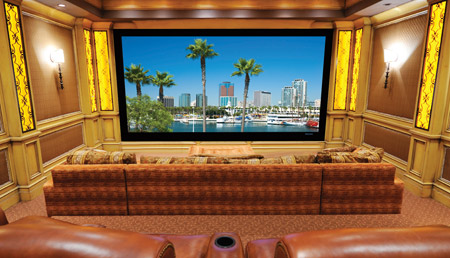Stewart Filmscreen Unveils Director's Choice 2.0 & Slimline CineCurve Screens
By Rachel Cericola
Screens as far as the eye can see. That's what it's like in a home theater fan's perfect world -- or at least what it's like inside the
Stewart Filmscreen booth at this week's CEDIA Expo. That's where the company is highlighting two of its new screens: the Director's Choice 2.0 and the Slimline CineCurve.
The CineCurve is one of Stewart's best sellers - it's a projection screen with a slightly concave design that provides an immersive home viewing experience. Now they've just put the CineCurve on a diet by making the outer frame a full one third narrower. The thinner frame makes it perfect for smaller theater rooms, or anywhere you want the movie to be the center of attention instead of the scren frame. They've knocked the width of the frame down from 18 to 12 inches, which means more image area for spaces that previously couldn’t accommodate larger screen sizes as well as a more discreet frame assembly.
Designed for use with a specially designed anamorphic lens that fits almost any HD projector, CineCurve models feature a native 2.40:1 aspect ratio. The unit also promises a constant vertical height (for watchng 16:9 and 4:3 material), thanks to two electronically controlled masking panels that glide in from the left and right.

The Director's Choice 2.0 boasts maximum picture size, regardless of the source's aspect ratio without electronic scaling artifacts.
If size does not matter, and you prefer the flat screen approach, the Director's Choice 2.0 is available to deliver a big, beautiful picture, regardless of the source's aspect ratio. A joint effort between Stewart and consulting firm PMI, LTD., this unit boasts the best screen materials and a precise masking system -- perfect for Anthony Grimani's PMI 2.0 video projection solution.
The Director's Choice 2.0 screen design reduces the amount of screen masking between picture formats and provides an automated method for displaying multiple aspect ratios. The four key components include: a projector with controllable zoom; Stewart's precision masking screen solution; system engineering; automation control. Stewart says that the system is so complete, it could actually be the last screen that you'll ever own. Now
that's a selling point!
There's no definitive word on availability of either screen yet, but considering Stewart's custom-friendly and surprisingly nimble manufacturing process (as described by editor Chris Boylan in his
Stewart Factory tour), it's likely both screen design options will be made available shortly to those who
really want one.
For More Information:
